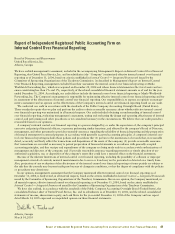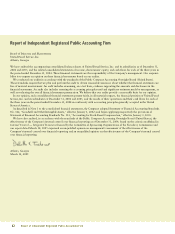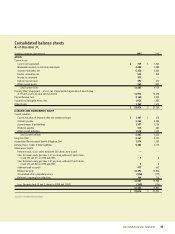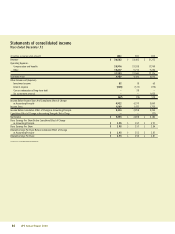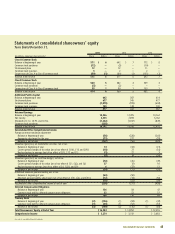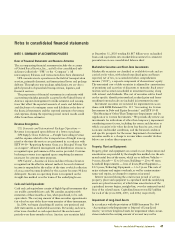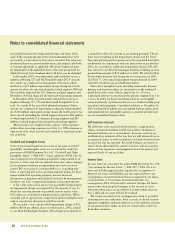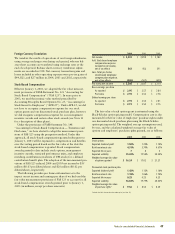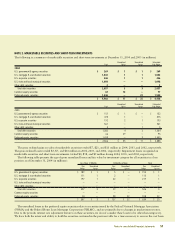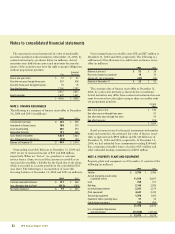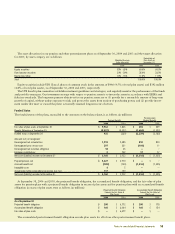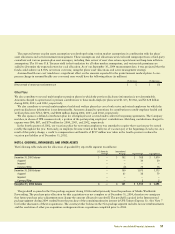UPS 2004 Annual Report Download - page 50
Download and view the complete annual report
Please find page 50 of the 2004 UPS annual report below. You can navigate through the pages in the report by either clicking on the pages listed below, or by using the keyword search tool below to find specific information within the annual report.
48 UPS Annual Report 2004
Notes to consolidated financial statements
recoverable based on the undiscounted future cash flows of the
asset. If the carrying amount of the asset is determined not to be
recoverable, a write-down to fair value is recorded. Fair values are
determined based on quoted market values, discounted cash flows,
or external appraisals, as applicable. We review long-lived assets
for impairment at the individual asset or the asset group level for
which the lowest level of independent cash flows can be identified.
In December 2003, we permanently removed from service a
number of Boeing 727 and McDonnell Douglas DC-8 aircraft.
As a result, we conducted an impairment evaluation, which
resulted in a $75 million impairment charge during the fourth
quarter for these aircraft (including the related engines), $69 mil-
lion of which impacted the U.S. domestic package segment and
$6 million of which impacted the international package segment.
In December 2004, we permanently removed from service a
number of Boeing 727, 747 and McDonnell Douglas DC-8 air-
craft. As a result of the actual and planned retirement of these
aircraft, we conducted an impairment evaluation, which resulted
in a $110 million impairment charge during the fourth quarter for
these aircraft (including the related engines and parts), $91 million
of which impacted the U.S. domestic package segment and $19
million of which impacted the international package segment.
These charges are classified in the caption “other expenses”
within other operating expenses (see Note 13). UPS continues to
operate all of its other aircraft and continues to experience posi-
tive cash flow.
Goodwill and Intangible Assets
Costs of purchased businesses in excess of net assets acquired
(goodwill), and intangible assets are accounted for under the
provisions of FASB Statement No. 142 “Goodwill and Other
Intangible Assets” (“FAS 142”). Upon adoption of FAS 142, we
were required to test all existing goodwill for impairment as of
January 1, 2002, and at least annually thereafter, unless changes
in circumstances indicate an impairment may have occurred
sooner. We are required to test goodwill on a “reporting unit”
basis. A reporting unit is the operating segment unless, for busi-
nesses within that operating segment, discrete financial
information is prepared and regularly reviewed by management,
in which case such a component business is the reporting unit.
A fair value approach is used to test goodwill for impairment.
An impairment charge is recognized for the amount, if any, by
which the carrying amount of goodwill exceeds its fair value.
Fair values are established using discounted cash flows. When
available and as appropriate, comparative market multiples were
used to corroborate discounted cash flow results.
We recorded a non-cash goodwill impairment charge of $72
million ($0.06 per diluted share) as of January 1, 2002, related
to our Mail Technologies business. This charge was reported as
a cumulative effect of a change in accounting principle. The pri-
mary factor resulting in the impairment charge was the lower
than anticipated growth experienced in the expedited mail deliv-
ery business. In conjunction with our annual test of goodwill in
2002, we recorded an additional impairment charge of $2 mil-
lion related to our Mail Technologies business, resulting in total
goodwill impairment of $74 million for 2002. We sold the Mail
Technologies business unit during the second quarter of 2003
(see Note 7). Our annual impairment tests performed in 2004
and 2003 resulted in no goodwill impairment.
Finite-lived intangible assets, including trademarks, licenses,
patents, and franchise rights are amortized over the estimated
useful lives of the assets, which range from 5 to 20 years.
Capitalized software is amortized over periods ranging from 3 to
5 years. In 2004, we began classifying software as intangible
assets. Previously, capitalized software was classified within prop-
erty, plant and equipment. Capitalized software at December 31,
2003 totaling $610 million was reclassified from property, plant
and equipment into intangible assets for consistent presentation
on our consolidated balance sheet.
Self-Insurance Accruals
We self-insure costs associated with workers’ compensation
claims, automotive liability, health and welfare, and general
business liabilities, up to certain limits. Insurance reserves are
established for estimates of the loss that we will ultimately incur
on reported claims, as well as estimates of claims that have been
incurred but not yet reported. Recorded balances are based on
reserve levels determined by outside actuaries, who incorporate
historical loss experience and judgments about the present and
expected levels of cost per claim.
Income Taxes
Income taxes are accounted for under FASB Statement No. 109,
“Accounting for Income Taxes” (“FAS 109”). FAS 109 is an
asset and liability approach that requires the recognition of
deferred tax assets and liabilities for the expected future tax
consequences of events that have been recognized in our finan-
cial statements or tax returns. In estimating future tax
consequences, FAS 109 generally considers all expected future
events other than proposed changes in the tax law or rates.
Valuation allowances are provided if it is more likely than not
that a deferred tax asset will not be realized.
We record accruals for tax contingencies related to potential
assessments by tax authorities. Such accruals are based on man-
agement’s judgment and best estimate as to the ultimate outcome
of any potential tax audits. Actual tax audit results could vary
from these estimates.





